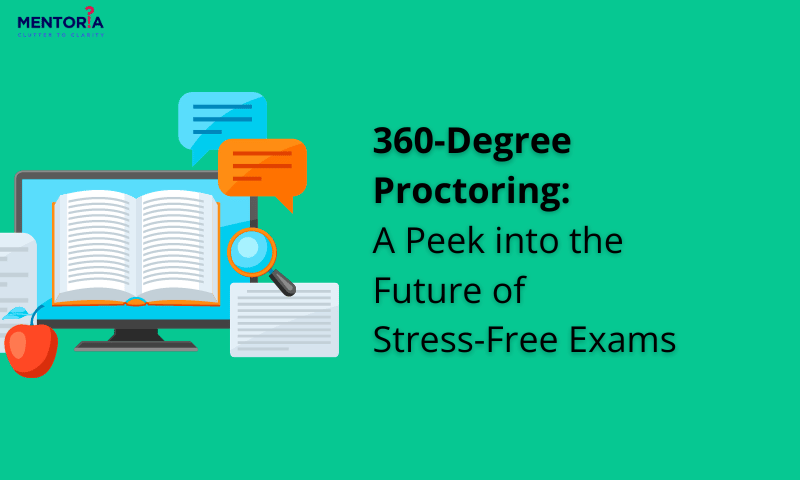360-Degree Proctoring: A Peek into the Future of Stress-Free Exams

Have you ever considered taking a test while curled up in your favourite recliner, a cup of tea in hand, and your cat by your side for moral support? Well, welcome to the 360-degree proctoring universe. It’s similar to having a virtual test companion who will watch out for you, but without the anxiety that comes with an in-person invigilator.
One of the most exciting developments in AI-powered exam fraud detection is 360-degree proctoring. This technology uses a combination of video, audio, and biometric data to create a complete picture of each student’s testing environment. This allows proctors to identify and flag suspicious behaviour, such as eye darting, whispering, or unauthorised use of electronic devices. AI is also being used to develop new and innovative ways to administer exams. For example, some companies are developing AI-powered adaptive exams that can adjust the difficulty of the questions in real time based on the student’s performance. This helps to ensure that all students are challenged at an appropriate level and that no one is given an unfair advantage.
Imagine there would be no more mad dashes for pens and calculators, no more trying to find your seat in the exam maze. The goal of 360-degree proctoring is to make exams as convenient and stress-free as feasible. We won’t judge if you show up to your exam in your jammies and yet ace it like a pro. Hey, we understand. Being constantly observed can sound a little bit, um, “Big Brother-ish.” Privacy is important, right? We’ll explore how this cutting-edge technology keeps a watchful eye without violating anyone’s privacy.
A Wide-Reaching Approach to Monitoring
When using a virtual proctoring system to oversee exam takers, 360-degree proctoring relies on thorough monitoring. Imagine taking an exam from the comfort of your home while being aware that cutting-edge technology is watching you from every aspect. A 360-degree view of the exam-taker’s surroundings and movements is made possible by the use of webcams and microphones. This provides an exam atmosphere that is fair and safe without the need for a physical proctor.
Webcams and microphones are used extensively in this futuristic strategy, which is one of its main components. These gadgets enable a 360-degree picture of the test-taker’s surroundings and movements throughout the examination. The software keeps track of everything, including head movements and suspicious noises, leaving a detailed digital trail of the exam session. The system highlights anything for further investigation if it seems suspicious.
Exam Security vs Privacy, Striking the Right Mix
Let’s now discuss the privacy issues that are the real elephant in the room. Naturally, the idea of being seen throughout an exam from all sides can cause some scepticism. But it’s crucial to strike a balance between protecting exam security and upholding someone’s privacy. To reassure students that their privacy is a major priority, institutions employing 360-degree proctoring must clearly describe how data will be gathered, stored, and used. A substantial component of 360-degree proctoring involves the utilisation of AI algorithms. These algorithms swiftly identify real-time exam anomalies and patterns of suspicious behaviour, whether they involve sudden head movements or unusual eye motions, promptly sending out alerts. This digital sentinel plays a pivotal role in upholding the examination’s integrity, guaranteeing a level playing field for all participants.
360-degree proctoring not only bolsters exam security but also offers the additional benefits of flexibility and convenience. As long as students have a reliable internet connection and the necessary equipment, they can take exams from virtually anywhere. This flexibility empowers students to showcase their knowledge in a comfortable setting, effectively reducing the stress typically associated with traditional test environments.
Artificial Intelligence, An Exams’ Benevolent Guardian
A substantial part of 360-degree proctoring includes AI algorithms. Real-time examination anomalies or patterns of suspicious conduct are picked up by these algorithms. AI-powered algorithms may detect anomalies in everything from sudden head movements to odd eye movements and send forth alerts. By preserving the integrity of the test, this digital guardian angel guarantees a level playing field for all participants.
Real-time Anomaly Detection: AI algorithms continuously monitor exam environments, looking for irregularities and suspicious behaviour. These algorithms can detect various anomalies, such as sudden head movements, unusual eye patterns, or unexpected noises in the background.
Behaviour Pattern Analysis: AI is capable of analysing and understanding behaviour patterns exhibited by test-takers. It can distinguish between normal test-taking behaviours and behaviours that may indicate dishonesty or cheating.
Alerts and Intervention: When AI identifies potential issues or irregularities, it can trigger alerts or notifications for human proctors or exam administrators. This allows for prompt intervention, ensuring the integrity of the examination process.
Flexibility and Convenience,The Added Perks
360-degree proctoring gives a more flexible and convenient exam experience while also enhancing exam security. If a student has a reliable internet connection and the appropriate equipment, they can take tests almost anywhere. This flexibility allows students to demonstrate their knowledge in a comfortable setting while lowering the stress associated with typical test settings.
Customised Exam Environments: Test-takers can choose an environment that suits their preferences and comfort. This personalised setting can help reduce the stress often associated with formal testing environments, leading to improved performance.
Reduced Scheduling Constraints: 360-degree proctoring allows for more flexible scheduling options. Students can often choose the time that works best for them within specified exam windows, accommodating various schedules and time zones.
Minimised Disruptions: Traditional in-person exams can be disrupted by factors like noise, distractions, or technical issues at the testing centre. With the ability to take exams from home or another chosen location, these disruptions can be significantly reduced.
Getting Past Obstacles, The Way Forward
While 360-degree proctoring has a lot of potential, there are some difficulties as well. Among the obstacles that institutions must overcome are technical hiccoughs, false positives, and false negatives. To reduce these issues and guarantee a smooth and dependable assessment process, ongoing technological advancements and refinements are essential.
Now that we’ve uncovered the 360-degree proctoring mystery and seen how it’s changing the exam landscape, let’s move on. Let’s consider the exciting future that technology provides and the potential disruptive effects it could have on how we conduct evaluations as we come to the end of this tech-driven voyage.
Let’s start by acknowledging the convenience and adaptability that 360-degree proctoring offers. The days of racing to a physical exam location and trembling to find your designated seat are quickly becoming a thing of the past. Exams become more approachable and flexible to our contemporary, mobile lifestyles using this method. You can pick the time and location that work best for you, whether it’s the convenience of your home or a quiet nook at your preferred café. Additionally, 360-degree proctoring is proof that technology can balance exam security and privacy. Although there is reason to be concerned about constant surveillance, the system is set up to preserve privacy while maintaining academic integrity. Institutions and technological innovators continue to put forth great effort to address these issues and build a reliable, open system. The cutting-edge technology that ensures an even playing field for all students is the real-time detection of suspicious conduct and anomalies. The days of perhaps misinterpreting a casual glance or unintentional twitch are long gone. The examination process gains an additional level of assurance and accuracy thanks to the AI component.
360-degree proctoring is a huge step toward a more student-centric, adaptable, and safe exam setting rather than just a look into the future. It’s a win-win situation since students experience less stress, more convenience, and a customised exam experience, while teachers can guarantee the validity of assessments. In order to change how we approach tests and make the process more about demonstrating knowledge and less about exam worries, let’s embrace this technological marvel with open arms and enthusiasm.
A Worry-Free Future With Mentoria
360-degree proctoring can help to reduce stress for candidates. Traditional proctoring methods can often be stressful and uncomfortable for candidates, as they may feel like they are being constantly watched. 360-degree proctoring, on the other hand, is less intrusive and allows candidates to take exams in a more relaxed and conducive environment. Here in Mentoria, we offer mentorship programmes that pairs students and professionals with experienced mentors who can provide them with guidance and support. Mentors can help individuals to learn about different careers, develop their skills, and navigate the job market. We also provide students and professionals with access to a variety of career resources, such as online courses, job postings, and networking opportunities.









